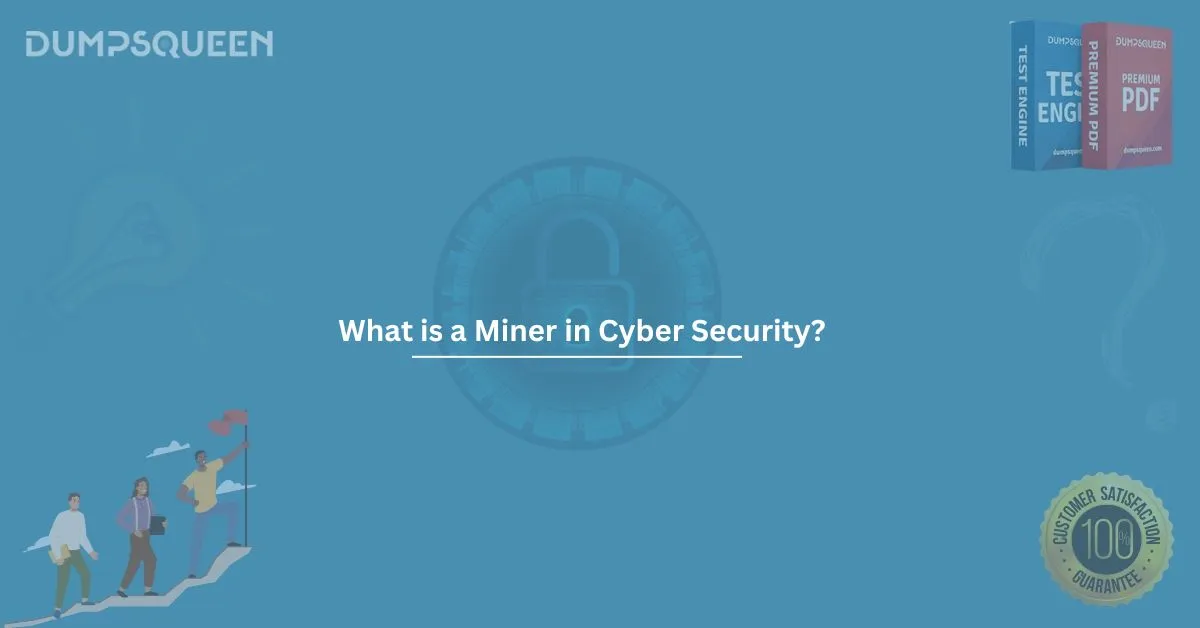In the ever-evolving landscape of cyber security, new threats and tactics emerge regularly, demanding attention and strategic countermeasures. One such phenomenon is the "miner"—a concept that is often misunderstood or overlooked. If you're wondering what is a miner in cyber security, you're not alone. This blog post will take a deep dive into the definition, functions, risks, and prevention methods associated with miners in cyber security contexts.
Whether you're preparing for a certification exam or simply seeking to broaden your knowledge, understanding miners is essential. Let’s explore what they are, how they operate, and why they're a growing concern in cyber security.
Understanding the Term: What is a Miner in Cyber Security?
In cyber security, a miner refers to a software, script, or malicious code that is designed to utilize a device’s computational resources to mine cryptocurrency without the user’s consent. This is also commonly referred to as crypto-jacking.
These miners are typically installed through malware, malicious websites, infected downloads, or browser-based scripts. The goal is to harness CPU or GPU power to generate cryptocurrency—most commonly Monero, due to its privacy-oriented features.
How Does a Miner Work in Cyber Security?
Here’s a simplified breakdown of how a miner operates in a cyber threat scenario:
- Infiltration: The miner gets installed on the victim's device through phishing emails, malicious ads, infected software, or unpatched vulnerabilities.
- Execution: Once active, the miner script or software starts running in the background.
- Resource Hijacking: The miner uses the system’s CPU/GPU to solve complex mathematical problems, which are part of the crypto mining process.
- Payout: The mined cryptocurrency is sent to the attacker’s digital wallet.
All of this typically occurs without the victim’s knowledge, leading to system slowdowns, overheating, reduced hardware lifespan, and increased electricity bills.
Common Types of Miners in Cyber Security Context
- Browser-Based Miners
- Operate via JavaScript embedded in websites.
- No installation required—just visiting the page triggers mining.
- Often seen in free-streaming sites or pirated content pages.
- File-Based Miners
- Distributed through infected downloads or attachments.
- Installed as a background process.
- Persistent even after a system reboot.
- Worm-Like Miners
- Spread across networks exploiting vulnerabilities.
- Can infect multiple machines in an organization.
- Rootkit Miners
- Highly sophisticated.
- Hide their presence by manipulating system processes.
Why Are Miners a Threat in Cyber Security?
While mining might sound harmless compared to data theft or ransomware, it can be just as dangerous in certain environments. Here’s why:
- Performance Degradation: Miners consume significant system resources, slowing down legitimate operations.
- Hardware Damage: Overheating due to high CPU/GPU use can damage components.
- Energy Costs: Increased energy usage leads to higher bills.
- Stealth Operation: Miners are hard to detect and often run silently for long periods.
- Gateway to Other Attacks: Miners can serve as initial access points for more severe malware, like ransomware.
How Do Cybercriminals Deploy Miners?
Here are common methods used by threat actors:
- Drive-by Downloads: Visiting a compromised website installs a miner in the background.
- Phishing Emails: Attachments or links may contain mining malware.
- Bundled Software: Freeware may include hidden mining components.
- Social Engineering: Users are tricked into installing fake updates or tools.
- Exploiting Vulnerabilities: Unpatched systems are prime targets for auto-mining scripts.
Detecting a Miner Attack
Miners are intentionally designed to avoid detection. However, there are several red flags:
- Unusual CPU/GPU Usage: If your system is running slow with high resource use during idle times, it’s a potential sign.
- System Overheating: Devices getting unusually hot.
- Slow Network Activity: Crypto miners often communicate with external servers.
- Task Manager Anomalies: Unrecognized processes consuming high resources.
- Browser Sluggishness: Long loading times or frequent crashes.
Tools like Windows Task Manager, Activity Monitor (macOS), or third-party anti-malware software can help detect suspicious activity.
Preventing and Mitigating Miner Attacks
To prevent and mitigate miner-based threats in cyber security, the following steps are crucial:
- Install Anti-Malware Tools
- Use updated anti-virus software with crypto-jacking detection capabilities.
- Patch and Update Regularly
- Always keep your OS, browsers, and plugins updated to avoid known vulnerabilities.
- Use Ad Blockers
- Tools like uBlock Origin can prevent miner scripts embedded in malicious ads.
- Block JavaScript
- Disable JavaScript for unknown or untrusted sites.
- Employee Education
- Train teams to recognize phishing and suspicious downloads.
- Monitor Network Traffic
- Use firewalls and intrusion detection systems to flag unusual data exchanges.
- Apply Group Policies
- In enterprise settings, enforce policies to block unauthorized processes and restrict admin privileges.
Real-World Incidents Involving Miners
- YouTube Ads Crypto Mining (2018)
- Hackers injected JavaScript mining code into YouTube ads using Google’s DoubleClick platform.
- Tesla’s Kubernetes Console Hack
- In 2018, hackers accessed Tesla’s unsecured Kubernetes console and deployed mining scripts using the company’s cloud infrastructure.
- Coinhive Browser Miner
- A once-legitimate tool that allowed websites to mine Monero via JavaScript, which was widely abused and later discontinued.
What is the Difference Between a Miner and a Typical Malware?
|
Feature |
Miner |
Traditional Malware |
|
Purpose |
Crypto mining |
Varies: theft, destruction |
|
Detection Difficulty |
Moderate to High |
Varies |
|
User Awareness |
Usually undetected |
Often more noticeable |
|
Harm Level |
Hardware/resource degradation |
Data loss, ransom, etc. |
Miner Risks in Corporate Environments
In organizational settings, a miner can:
- Slow productivity due to performance drops.
- Increase IT support costs to resolve overheating, crashes.
- Serve as an access point for more dangerous malware.
- Create compliance issues in regulated industries (e.g., finance, healthcare).
Legal and Ethical Implications
While crypto mining itself is legal, unauthorized mining on someone else's system is not. It violates:
- Privacy laws
- Computer Misuse Acts
- Corporate IT policies
Even using organizational resources for personal mining—without malware—can lead to disciplinary actions or legal consequences.
Conclusion: Staying Ahead of Miner Threats
Now that you understand what is a miner in cyber security, it’s clear that these seemingly minor threats can have major consequences. Crypto-mining malware is stealthy, resource-draining, and potentially harmful to both individuals and organizations.
The key to managing this threat lies in awareness, prevention, and regular system monitoring. By implementing best practices and using the right tools, you can protect yourself and your organization from falling victim to this silent and financially motivated cyber attack.
For students and professionals preparing for cyber security certifications, understanding crypto miners and related threats is crucial for exam success. At DumpsQueen, we provide verified resources and practice dumps to help you master these core concepts and more.
Sample MCQ Questions on What is a Miner in Cyber Security
1. What is the primary purpose of a miner in cyber security threats?
A) Steal login credentials
B) Encrypt files for ransom
C) Mine cryptocurrency using system resources
D) Spy on user activity
Answer: C) Mine cryptocurrency using system resources
2. Which of the following is a common sign of crypto mining malware?
A) Reduced screen brightness
B) High CPU/GPU usage during idle times
C) Disconnected Wi-Fi
D) Missing browser bookmarks
Answer: B) High CPU/GPU usage during idle times
3. How are miners commonly delivered to a victim's system?
A) Through antivirus updates
B) Via phishing emails and drive-by downloads
C) Through official software channels
D) Via Bluetooth pairing
Answer: B) Via phishing emails and drive-by downloads
4. What type of cryptocurrency is most commonly associated with illegal mining activities due to its privacy features?
A) Bitcoin
B) Ethereum
C) Litecoin
D) Monero
Answer: D) Monero




